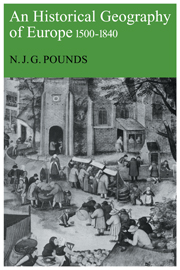Book contents
- Frontmatter
- Contents
- List of maps and diagrams
- List of abbreviations
- Preface
- 1 Europe in the early sixteenth century
- 2 The population of Europe from the sixteenth to the early nineteenth centuries
- 3 The pattern of cities
- 4 Agriculture from the sixteenth to the nineteenth centuries
- 5 Manufacturing and mining
- 6 The pattern of trade
- 7 Europe on the eve of the Industrial Revolution
- Notes
- Index
6 - The pattern of trade
Published online by Cambridge University Press: 04 August 2010
- Frontmatter
- Contents
- List of maps and diagrams
- List of abbreviations
- Preface
- 1 Europe in the early sixteenth century
- 2 The population of Europe from the sixteenth to the early nineteenth centuries
- 3 The pattern of cities
- 4 Agriculture from the sixteenth to the nineteenth centuries
- 5 Manufacturing and mining
- 6 The pattern of trade
- 7 Europe on the eve of the Industrial Revolution
- Notes
- Index
Summary
During the three centuries from the sixteenth to the early nineteenth the prevailing economic principles were those commonly known as mercantilism or cameralism. This body of doctrine took shape gradually, but its end was abrupt as the ideas of free trade and international competition spread to continental Europe from Great Britain. Two aspects of mercantilist doctrine are particularly significant in the context of this chapter. The first was the view that the precious metals were the ultimate repository of wealth. A country should aim to accumulate bullion; its export trade should exceed its imports in value, with the excess paid for with precious metals. In Mun's words, written in the early seventeenth century, ‘wee must ever observe this rule: to sell more to strangers yearly than we consume of theirs in value … because that part of our stock which is not returned to us in wares must necessarily be brought home in treasure’.
The second aspect of mercantilism derived from the first. One country should be dependent upon another only to the smallest degree possible; it should grow or manufacture as much as it could of what it needed. To do otherwise would be to give hostages to its neighbours and rivals, and to risk an outflow of bullion. Mercantilist policies were applied with varying degrees of completeness and understanding. In Great Britain and the Netherlands they were tempered by the high degree of freedom and initiative allowed to the individual merchant. In France and Prussia the state assumed a vigorous and authoritarian role in dictating economic policy.
- Type
- Chapter
- Information
- An Historical Geography of Europe, 1500-1840 , pp. 272 - 306Publisher: Cambridge University PressPrint publication year: 1980



